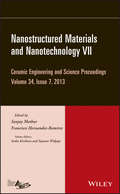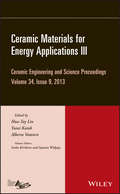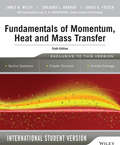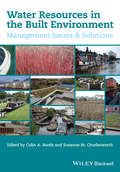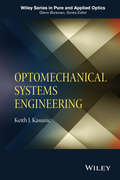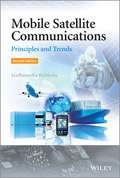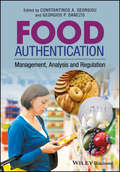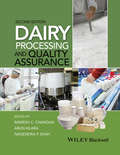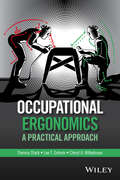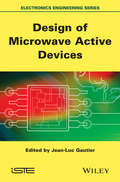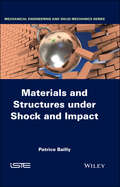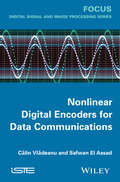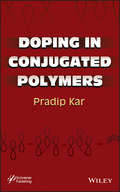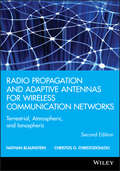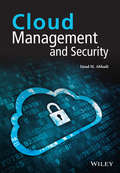- Table View
- List View
Nanostructured Materials and Nanotechnology VII (Ceramic Engineering and Science Proceedings #585)
by Soshu Kirihara Sujanto WidjajaCeramic Engineering and Science Proceedings Volume 34, Issue 7 - Nanostructured Materials and Nanotechnology VII A collection of 15 papers from The American Ceramic Society’s 37th International Conference on Advanced Ceramics and Composites, held in Daytona Beach, Florida, January 27-February 1, 2013. This issue includes papers presented in the 7th International Symposium on Nanostructured Materials and Nanotechnology (Symposium 7) and Nanomaterials for Sensing Applications symposia (Focused Session 3).
Ceramic Materials for Energy Applications III (Ceramic Engineering and Science Proceedings #587)
by Soshu Kirihara Sujanto WidjajaCeramic Engineering and Science Proceedings Volume 34, Issue 9 - Ceramic Materials for Energy Applications III A collection of 15 papers from The American Ceramic Society’s 37th International Conference on Advanced Ceramics and Composites, held in Daytona Beach, Florida, January 27-February 1, 2013. This issue includes papers presented in Symposia 6 - Advanced Materials and Technologies for Rechargeable Energy Storage; Symposium 13 - Advanced Ceramics and Composites for Sustainable Nuclear Energy and Fusion Energy; Focused Session 4 - Advanced Processing for Photonics and Energy; and the Engineering Summit of the Americas session.
Fundamentals of Momentum, Heat and Mass Transfer, 6th Edition International Student Version
by James Welty Gregory L. Rorrer David G. FosterFundamentals of Momentum, Heat, and Mass Transfer, now in its sixth edition, continues to provide a unified treatment of momentum transfer (fluid mechanics), heat transfer, and mass transfer. This new edition has been updated to include more coverage of modern topics and new applications, such as macro- and micro-scale chemical reactors. Additionally, the sixth edition focuses on an explicit problem-solving methodology that is thoroughly and consistently implemented throughout the text. It is designed for undergraduates taking transport phenomena or transfer and rate process courses.
Water Resources in the Built Environment: Management Issues and Solutions
by Colin A. BoothWater management is a key environmental issue in controlling of floods and reducing droughts. This book provides analysis of the main issues, offering solutions and describing good practice. Water Resources for the Built Environment: management issues and solutions develops an appreciation of the diverse, complex and current themes of the water resources debate across the built environment, urban development and management continuum. The integration of physical and environmental sciences, combined with social, economic and political sciences, provide a unique resource, useful to policy experts, scientists, engineers and subject enthusiasts. By taking an interdisciplinary approach, water resources issues and impacts on the built environment are presented in the inventive and strategic setting of considering the constraints of delivering potable water to an ever-demanding society who, at the same time, are increasingly aware of living in an urban landscape where excessive surface water creates a flood threatened environment – hence, the need to portray a balance between ‘too little vs. too much’. This unique approach to the water resources debate presents a multifaceted collection of chapters that address the contemporary concomitant issues of water shortage and urban flooding and proffers solutions specifically for the built environment. The book is structured into three parts: the first part (Sections 2, 3 and 4) addresses management issues and solutions to minimise water shortages and provide water security for society; whilst the second part of the book (Sections 5 and 6) addresses management issues and solutions to control excessive rainfall and minimise flooding impacts. The third part (Section 7) contextualises the issues of the earlier sections within international case studies from the developing world.
Water Resources in the Built Environment: Management Issues and Solutions
by Colin A. Booth Susanne M. CharlesworthWater management is a key environmental issue in controlling of floods and reducing droughts. This book provides analysis of the main issues, offering solutions and describing good practice. Water Resources for the Built Environment: management issues and solutions develops an appreciation of the diverse, complex and current themes of the water resources debate across the built environment, urban development and management continuum. The integration of physical and environmental sciences, combined with social, economic and political sciences, provide a unique resource, useful to policy experts, scientists, engineers and subject enthusiasts. By taking an interdisciplinary approach, water resources issues and impacts on the built environment are presented in the inventive and strategic setting of considering the constraints of delivering potable water to an ever-demanding society who, at the same time, are increasingly aware of living in an urban landscape where excessive surface water creates a flood threatened environment – hence, the need to portray a balance between ‘too little vs. too much’. This unique approach to the water resources debate presents a multifaceted collection of chapters that address the contemporary concomitant issues of water shortage and urban flooding and proffers solutions specifically for the built environment. The book is structured into three parts: the first part (Sections 2, 3 and 4) addresses management issues and solutions to minimise water shortages and provide water security for society; whilst the second part of the book (Sections 5 and 6) addresses management issues and solutions to control excessive rainfall and minimise flooding impacts. The third part (Section 7) contextualises the issues of the earlier sections within international case studies from the developing world.
Optomechanical Systems Engineering (Wiley Series in Pure and Applied Optics)
by Keith J. KasunicCovers the fundamental principles behind optomechanical design This book emphasizes a practical, systems-level overview of optomechanical engineering, showing throughout how the requirements on the optical system flow down to those on the optomechanical design. The author begins with an overview of optical engineering, including optical fundamentals as well as the fabrication and alignment of optical components such as lenses and mirrors. The concepts of optomechanical engineering are then applied to the design of optical systems, including the structural design of mechanical and optical components, structural dynamics, thermal design, and kinematic design. Optomechanical Systems Engineering: Reviews the fundamental concepts of optical engineering as they apply to optomechanical design Illustrates the fabrication and alignment requirements typically found in an optical system Examines the elements of structural design from a mechanical, optical, and vibrational viewpoint Develops the thermal management principles of temperature and distortion control Describes the optomechanical requirements for kinematic and semi-kinematic mounts Uses examples and case studies to illustrate the concepts and equations presented in the book Provides supplemental materials on a companion website Focusing on fundamental concepts and first-order estimates of optomechanical system performance, Optomechanical Systems Engineering is accessible to engineers, scientists, and managers who want to quickly master the principles of optomechanical engineering.
Mobile Satellite Communications: Principles and Trends
by Madhavendra RichhariaDemand for Mobile Satellite Service (MSS) is on the increase, with a huge surge of interest in mobile communications in recent years and high-paced advancements in the supporting system architectures, devices and applications. This thoroughly revised and updated book provides a comprehensive guide to the MSS technologies and emerging trends. It takes a system level approach, giving in-depth treatment of technical and business related issues. The author, a leading professional in the area, draws on his extensive experience in industry and research, to provide the reader with a sound and informed understanding of the technology. Mobile Satellite Communications includes introductory material for the reader new to the field, in addition to exploring prevalent system concepts, architecture, practices and trends for the more experienced. An in-depth review of scientific principles merged with business models and regulatory considerations presents a balanced perspective of commercial mobile satellite systems. This book will be of interest to practicing engineers in mobile satellite communications and mobile broadcasting, research and development professionals working in these areas, mobile satellite service providers and operators. Academics and students studying satellite systems/technology, specialists in other classes of satellite systems, technical and marketing managers, strategists and planners of telecommunication systems: individuals interested in mobile communications, satellite and telecommunications/broadcasting technology will also find this book insightful. Key Features: Comprehensive treatment of mobile satellite communications topics, including radio link aspects, satellite constellations, architectural and operational aspects, as well as business planning models, MSS radio interface standards, spectrum forecast methodologies and system examples. Addresses related themes such as mobile broadcasting, mobile VSATs, search and rescue, and navigation systems. Introduces emerging technologies such as mobile broadband, television broadcasting to handheld units, advanced capacity enhancement techniques, hybrid system architecture concepts, including a rich sample of research topics such as multiple input multiple output, satellite-based ad-hoc networks, and highlights initiatives in the use of Q/V frequency bands. Includes revision questions at the end of each chapter. An accompanying website for interaction (www.satellitesandyou.com).
Food Authentication: Management, Analysis and Regulation
by Contantinos A. Georgiou Georgios P. DanezisThe determination of food authenticity is a vital component of quality control. Its importance has been highlighted in recent years by high-profile cases in the global supply chain such as the European horsemeat scandal and the Chinese melamine scandal which led to six fatalities and the hospitalisation of thousands of infants. As well as being a safety concern, authenticity is also a quality criterion for food and food ingredients. Consumers and retailers demand that the products they purchase and sell are what they purport to be. This book covers the most advanced techniques used for the authentication of a vast number of products around the world. The reader will be informed about the latest pertinent analytical techniques. Chapters focus on the novel techniques & markers that have emerged in recent years. An introductory section presents the concepts of food authentication while the second section examines in detail the analytical techniques for the detection of fraud relating to geographical, botanical, species and processing origin and production methods of food materials and ingredients. Finally, the third section looks at consumer attitudes towards food authenticity, the application of bioinformatics to this field, and the Editor’s conclusions and future outlook. Beyond being a reference to researchers working in food authentication it will serve as an essential source to analytical scientists interested in the field and food scientists to appreciate analytical approaches. This book will be a companion to under- and postgraduate students in their wander in food authentication and aims to be useful to researchers in universities and research institutions.
Food Authentication: Management, Analysis and Regulation
by Constantinos A. Georgiou Georgios P. DanezisThe determination of food authenticity is a vital component of quality control. Its importance has been highlighted in recent years by high-profile cases in the global supply chain such as the European horsemeat scandal and the Chinese melamine scandal which led to six fatalities and the hospitalisation of thousands of infants. As well as being a safety concern, authenticity is also a quality criterion for food and food ingredients. Consumers and retailers demand that the products they purchase and sell are what they purport to be. This book covers the most advanced techniques used for the authentication of a vast number of products around the world. The reader will be informed about the latest pertinent analytical techniques. Chapters focus on the novel techniques & markers that have emerged in recent years. An introductory section presents the concepts of food authentication while the second section examines in detail the analytical techniques for the detection of fraud relating to geographical, botanical, species and processing origin and production methods of food materials and ingredients. Finally, the third section looks at consumer attitudes towards food authenticity, the application of bioinformatics to this field, and the Editor’s conclusions and future outlook. Beyond being a reference to researchers working in food authentication it will serve as an essential source to analytical scientists interested in the field and food scientists to appreciate analytical approaches. This book will be a companion to under- and postgraduate students in their wander in food authentication and aims to be useful to researchers in universities and research institutions.
Dairy Processing and Quality Assurance
by Ramesh C. Chandan Arun Kilara Nagendra P. ShahDairy Processing and Quality Assurance, Second Edition describes the processing and manufacturing stages of market milk and major dairy products, from the receipt of raw materials to the packaging of the products, including the quality assurance aspects. The book begins with an overview of the dairy industry, dairy production and consumption trends. Next are discussions related to chemical, physical and functional properties of milk; microbiological considerations involved in milk processing; regulatory compliance; transportation to processing plants; and the ingredients used in manufacture of dairy products. The main section of the book is dedicated to processing and production of fluid milk products; cultured milk including yogurt; butter and spreads; cheese; evaporated and condensed milk; dry milks; whey and whey products; ice cream and frozen desserts; chilled dairy desserts; nutrition and health; sensory evaluation; new product development strategies; packaging systems; non-thermal preservation technologies; safety and quality management systems; and dairy laboratory analytical techniques. This fully revised and updated edition highlights the developments which have taken place in the dairy industry since 2008. The book notably includes: New regulatory developments The latest market trends New processing developments, particularly with regard to yogurt and cheese products Functional aspects of probiotics, prebiotics and synbiotics A new chapter on the sensory evaluation of dairy products Intended for professionals in the dairy industry, Dairy Processing and Quality Assurance, Second Edition, will also appeal to researchers, educators and students of dairy science for its contemporary information and experience-based applications.
Dairy Processing and Quality Assurance
by Ramesh C. Chandan Arun Kilara Nagendra P. ShahDairy Processing and Quality Assurance, Second Edition describes the processing and manufacturing stages of market milk and major dairy products, from the receipt of raw materials to the packaging of the products, including the quality assurance aspects. The book begins with an overview of the dairy industry, dairy production and consumption trends. Next are discussions related to chemical, physical and functional properties of milk; microbiological considerations involved in milk processing; regulatory compliance; transportation to processing plants; and the ingredients used in manufacture of dairy products. The main section of the book is dedicated to processing and production of fluid milk products; cultured milk including yogurt; butter and spreads; cheese; evaporated and condensed milk; dry milks; whey and whey products; ice cream and frozen desserts; chilled dairy desserts; nutrition and health; sensory evaluation; new product development strategies; packaging systems; non-thermal preservation technologies; safety and quality management systems; and dairy laboratory analytical techniques. This fully revised and updated edition highlights the developments which have taken place in the dairy industry since 2008. The book notably includes: New regulatory developments The latest market trends New processing developments, particularly with regard to yogurt and cheese products Functional aspects of probiotics, prebiotics and synbiotics A new chapter on the sensory evaluation of dairy products Intended for professionals in the dairy industry, Dairy Processing and Quality Assurance, Second Edition, will also appeal to researchers, educators and students of dairy science for its contemporary information and experience-based applications.
Occupational Ergonomics: A Practical Approach
by Theresa Stack Lee T. Ostrom Cheryl A. WilhelmsenThe approach to the book is analogous to a toolkit. The user will open the book and locate the tool that best fits the ergonomic assessment task he/she is performing. The chapters of the book progress from the concept of ergonomics, through the various assessment techniques, and into the more complex techniques. In addition to discussing the techniques, this book presents them in a form that the readers can readily adapt to their particular situation. Each chapter, where applicable, presents the technique discussed in that chapter and demonstrates how it is used. The supporting material at the end of each chapter contains exercises, case studies and review questions. The case study section of the book presents how to use techniques to analyze a range of workplace scenarios. Topics include: The Basics of Ergonomics; Anthropometry; Office Ergonomics; Administrative Controls; Biomechanics; Hand Tools; Vibration; Workstation Design; Manual Material Handling; Job Requirements and Physical Demands Survey; Ergonomic Survey Tools; Work-related Musculoskeletal Disorders; How to Conduct an Ergonomics Assessment; and Case Studies
Occupational Ergonomics: A Practical Approach
by Theresa Stack Lee T. Ostrom Cheryl A. WilhelmsenThe approach to the book is analogous to a toolkit. The user will open the book and locate the tool that best fits the ergonomic assessment task he/she is performing. The chapters of the book progress from the concept of ergonomics, through the various assessment techniques, and into the more complex techniques. In addition to discussing the techniques, this book presents them in a form that the readers can readily adapt to their particular situation. Each chapter, where applicable, presents the technique discussed in that chapter and demonstrates how it is used. The supporting material at the end of each chapter contains exercises, case studies and review questions. The case study section of the book presents how to use techniques to analyze a range of workplace scenarios. Topics include: The Basics of Ergonomics; Anthropometry; Office Ergonomics; Administrative Controls; Biomechanics; Hand Tools; Vibration; Workstation Design; Manual Material Handling; Job Requirements and Physical Demands Survey; Ergonomic Survey Tools; Work-related Musculoskeletal Disorders; How to Conduct an Ergonomics Assessment; and Case Studies
Design of Microwave Active Devices
by Jean-Luc GautierThis book presents methods for the design of the main microwave active devices. The first chapter focuses on amplifiers working in the linear mode. The authors present the problems surrounding narrowband and wideband impedance matching, stability, polarization and the noise factor, as well as specific topologies such as the distributed amplifier and the differential amplifier. Chapter 2 concerns the power amplifier operation. Specific aspects on efficiency, impedance matching and class of operation are presented, as well as the main methods of linearization and efficiency improvement. Frequency transposition is the subject of Chapter 3. The author presents the operating principle as well as the different topologies using transistors and diodes. Chapter 4 is dedicated to the operation of fixed frequency and tunable oscillators such as the voltage controlled oscillator (VCO) and the yttrium iron garnet (YIG). The final chapter presents the main control functions, i.e. attenuators, phase shifters and switches.
Design of Microwave Active Devices
by Jean-Luc GautierThis book presents methods for the design of the main microwave active devices. The first chapter focuses on amplifiers working in the linear mode. The authors present the problems surrounding narrowband and wideband impedance matching, stability, polarization and the noise factor, as well as specific topologies such as the distributed amplifier and the differential amplifier. Chapter 2 concerns the power amplifier operation. Specific aspects on efficiency, impedance matching and class of operation are presented, as well as the main methods of linearization and efficiency improvement. Frequency transposition is the subject of Chapter 3. The author presents the operating principle as well as the different topologies using transistors and diodes. Chapter 4 is dedicated to the operation of fixed frequency and tunable oscillators such as the voltage controlled oscillator (VCO) and the yttrium iron garnet (YIG). The final chapter presents the main control functions, i.e. attenuators, phase shifters and switches.
Materials and Structures under Shock and Impact
by Patrice BaillyIn risk studies, engineers often have to consider the consequences of an accident leading to a shock on a construction. This can concern the impact of a ground vehicle or aircraft, or the effects of an explosion on an industrial site. This book presents a didactic approach starting with the theoretical elements of the mechanics of materials and structures, in order to develop their applications in the cases of shocks and impacts. The latter are studied on a local scale at first. They lead to stresses and strains in the form of waves propagating through the material, this movement then extending to the whole of the structure. The first part of the book is devoted to the study of solid dynamics where nonlinear behaviors come into play. The second part covers structural dynamics and the evaluation of the transient response introduced at the global scale of a construction. Practical methods, simplified methods and methods that are in current use by engineers are also proposed throughout the book. The aim of this book is to present theoretical elements regarding solids and structures, as well as modeling tools in order to study the vulnerability of a structure to a short duration action, generally of accidental nature. The book takes the point of view of an engineer seeking for the modeling of the physics at stake to relevantly carry out his study. The book originality is that it gathers elements from various fields of engineering sciences, for the purpose of a practical objective.
Materials and Structures under Shock and Impact (Iste Ser.)
by Patrice BaillyIn risk studies, engineers often have to consider the consequences of an accident leading to a shock on a construction. This can concern the impact of a ground vehicle or aircraft, or the effects of an explosion on an industrial site. This book presents a didactic approach starting with the theoretical elements of the mechanics of materials and structures, in order to develop their applications in the cases of shocks and impacts. The latter are studied on a local scale at first. They lead to stresses and strains in the form of waves propagating through the material, this movement then extending to the whole of the structure. The first part of the book is devoted to the study of solid dynamics where nonlinear behaviors come into play. The second part covers structural dynamics and the evaluation of the transient response introduced at the global scale of a construction. Practical methods, simplified methods and methods that are in current use by engineers are also proposed throughout the book. The aim of this book is to present theoretical elements regarding solids and structures, as well as modeling tools in order to study the vulnerability of a structure to a short duration action, generally of accidental nature. The book takes the point of view of an engineer seeking for the modeling of the physics at stake to relevantly carry out his study. The book originality is that it gathers elements from various fields of engineering sciences, for the purpose of a practical objective.
Nonlinear Digital Encoders for Data Communications
by Calin Vladeanu Safwan El AssadThis book presents digital encoders for data communications. After an introduction on data communications and different sequences, the authors present the frey encoder as a digital filter followed by the trellis-coded and parallel turbo trellis-coded modulation schemes using nonlinear digital encoders.The book contains many numerical examples that complete the description of the analyzed schemes. Also, some performance simulation results are provided. Appendixes include demonstrations for the mathematical apparatus used throughout the book and some Matlab/Simulink source files used to run the simulations. Therefore, students can easily understand the concepts presented in the book and to simulate the schemes.
Nonlinear Digital Encoders for Data Communications (Focus Ser.)
by Calin Vladeanu Safwan El AssadThis book presents digital encoders for data communications. After an introduction on data communications and different sequences, the authors present the frey encoder as a digital filter followed by the trellis-coded and parallel turbo trellis-coded modulation schemes using nonlinear digital encoders.The book contains many numerical examples that complete the description of the analyzed schemes. Also, some performance simulation results are provided. Appendixes include demonstrations for the mathematical apparatus used throughout the book and some Matlab/Simulink source files used to run the simulations. Therefore, students can easily understand the concepts presented in the book and to simulate the schemes.
Doping in Conjugated Polymers (Polymer Science and Plastics Engineering)
by Pradip KarAn A-to-Z of doping including its definition, its importance, methods of measurement, advantages and disadvantages, properties and characteristics—and role in conjugated polymers The versatility of polymer materials is expanding because of the introduction of electro-active behavior into the characteristics of some of them. The most exciting development in this area is related to the discovery of intrinsically conductive polymers or conjugated polymers, which include such examples as polyacetylene, polyaniline, polypyrrole, and polythiophene as well as their derivatives. "Synmet" or "synthetic metal" conjugated polymers, with their metallic characteristics, including conductivity, are of special interest to researchers. An area of limitless potential and application, conjugated polymers have sparked enormous interest, beginning in 2000 when the Nobel Prize for the discovery and development of electrically conducting conjugated polymers was awarded to three scientists: Alan J. Heeger, Alan G. MacDiarmid, and Hideki Shirakawa. Conjugated polymers have a combination of properties—both metallic (conductivity) and polymeric; doping gives the conjugated polymer's semiconducting a wide range of conductivity, from insulating to low conducting. The doping process is a tested effective method for producing conducting polymers as semiconducting material, providing a substitute for inorganic semiconductors. Doping in Conjugated Polymers is the first book dedicated to the subject and offers a comprehensive A-to-Z overview. It details doping interaction, dopant types, doping techniques, and the influence of the dopant on applications. It explains how the performance of doped conjugated polymers is greatly influenced by the nature of the dopants and their level of distribution within the polymer, and shows how the electrochemical, mechanical, and optical properties of the doped conjugated polymers can be tailored by controlling the size and mobility of the dopants counter ions. The book also examines doping at the nanoscale, in particular, with carbon nanotubes. Readership The book will interest a broad range of researchers including chemists, electrochemists, biochemists, experimental and theoretical physicists, electronic and electrical engineers, polymer and materials scientists. It can also be used in both graduate and upper-level undergraduate courses on conjugated polymers and polymer technology.
Radio Propagation and Adaptive Antennas for Wireless Communication Networks: Terrestrial, Atmospheric, and Ionospheric (Wiley Series in Microwave and Optical Engineering)
by Nathan Blaunstein Christos G. ChristodoulouRadio Propagation and Adaptive Antennas for Wireless Communication Networks, 2nd Edition, presents a comprehensive overview of wireless communication system design, including the latest updates to considerations of over-the-terrain, atmospheric, and ionospheric communication channels. New features include the latest experimentally-verified stochastic approach, based on several multi-parametric models; all-new chapters on wireless network fundamentals, advanced technologies, and current and modern multiple access networks; and helpful problem sets at the conclusion of each chapter to enhance clarity. The volume’s emphasis remains on a thorough examination of the role of obstructions on the corresponding propagation phenomena that influence the transmission of radio signals through line-of-sight (LOS) and non-line-of-sight (NLOS) propagation conditions along the radio path between the transmitter and the receiver antennas—and how adaptive antennas, used at the link terminals, can be used to minimize the deleterious effects of such obstructions. With its focus on 3G, 4G, MIMO, and the latest wireless technologies, Radio Propagation and Adaptive Antennas for Wireless Communication Networks represents an invaluable resource to topics critical to the design of contemporary wireless communication systems. Explores novel wireless networks beyond 3G, and advanced 4G technologies, such as MIMO, via propagation phenomena and the fundamentals of adapted antenna usage. Explains how adaptive antennas can improve GoS and QoS for any wireless channel, with specific examples and applications in land, aircraft and satellite communications. Introduces new stochastic approach based on several multi-parametric models describing various terrestrial scenarios, which have been experimentally verified in different environmental conditions New chapters on fundamentals of wireless networks, cellular and non-cellular, multiple access networks, new applications of adaptive antennas for positioning, and localization of subscribers Includes the addition of problem sets at the end of chapters describing fundamental aspects of wireless communication and antennas.
Radio Propagation and Adaptive Antennas for Wireless Communication Networks: Terrestrial, Atmospheric, and Ionospheric (Wiley Series in Microwave and Optical Engineering)
by Nathan Blaunstein Christos G. ChristodoulouRadio Propagation and Adaptive Antennas for Wireless Communication Networks, 2nd Edition, presents a comprehensive overview of wireless communication system design, including the latest updates to considerations of over-the-terrain, atmospheric, and ionospheric communication channels. New features include the latest experimentally-verified stochastic approach, based on several multi-parametric models; all-new chapters on wireless network fundamentals, advanced technologies, and current and modern multiple access networks; and helpful problem sets at the conclusion of each chapter to enhance clarity. The volume’s emphasis remains on a thorough examination of the role of obstructions on the corresponding propagation phenomena that influence the transmission of radio signals through line-of-sight (LOS) and non-line-of-sight (NLOS) propagation conditions along the radio path between the transmitter and the receiver antennas—and how adaptive antennas, used at the link terminals, can be used to minimize the deleterious effects of such obstructions. With its focus on 3G, 4G, MIMO, and the latest wireless technologies, Radio Propagation and Adaptive Antennas for Wireless Communication Networks represents an invaluable resource to topics critical to the design of contemporary wireless communication systems. Explores novel wireless networks beyond 3G, and advanced 4G technologies, such as MIMO, via propagation phenomena and the fundamentals of adapted antenna usage. Explains how adaptive antennas can improve GoS and QoS for any wireless channel, with specific examples and applications in land, aircraft and satellite communications. Introduces new stochastic approach based on several multi-parametric models describing various terrestrial scenarios, which have been experimentally verified in different environmental conditions New chapters on fundamentals of wireless networks, cellular and non-cellular, multiple access networks, new applications of adaptive antennas for positioning, and localization of subscribers Includes the addition of problem sets at the end of chapters describing fundamental aspects of wireless communication and antennas.
Doping in Conjugated Polymers (Polymer Science and Plastics Engineering)
by Pradip KarAn A-to-Z of doping including its definition, its importance, methods of measurement, advantages and disadvantages, properties and characteristics—and role in conjugated polymers The versatility of polymer materials is expanding because of the introduction of electro-active behavior into the characteristics of some of them. The most exciting development in this area is related to the discovery of intrinsically conductive polymers or conjugated polymers, which include such examples as polyacetylene, polyaniline, polypyrrole, and polythiophene as well as their derivatives. "Synmet" or "synthetic metal" conjugated polymers, with their metallic characteristics, including conductivity, are of special interest to researchers. An area of limitless potential and application, conjugated polymers have sparked enormous interest, beginning in 2000 when the Nobel Prize for the discovery and development of electrically conducting conjugated polymers was awarded to three scientists: Alan J. Heeger, Alan G. MacDiarmid, and Hideki Shirakawa. Conjugated polymers have a combination of properties—both metallic (conductivity) and polymeric; doping gives the conjugated polymer's semiconducting a wide range of conductivity, from insulating to low conducting. The doping process is a tested effective method for producing conducting polymers as semiconducting material, providing a substitute for inorganic semiconductors. Doping in Conjugated Polymers is the first book dedicated to the subject and offers a comprehensive A-to-Z overview. It details doping interaction, dopant types, doping techniques, and the influence of the dopant on applications. It explains how the performance of doped conjugated polymers is greatly influenced by the nature of the dopants and their level of distribution within the polymer, and shows how the electrochemical, mechanical, and optical properties of the doped conjugated polymers can be tailored by controlling the size and mobility of the dopants counter ions. The book also examines doping at the nanoscale, in particular, with carbon nanotubes. Readership The book will interest a broad range of researchers including chemists, electrochemists, biochemists, experimental and theoretical physicists, electronic and electrical engineers, polymer and materials scientists. It can also be used in both graduate and upper-level undergraduate courses on conjugated polymers and polymer technology.
Cloud Management and Security
by Imad M. AbbadiWritten by an expert with over 15 years’ experience in the field, this book establishes the foundations of Cloud computing, building an in-depth and diverse understanding of the technologies behind Cloud computing. In this book, the author begins with an introduction to Cloud computing, presenting fundamental concepts such as analyzing Cloud definitions, Cloud evolution, Cloud services, Cloud deployment types and highlighting the main challenges. Following on from the introduction, the book is divided into three parts: Cloud management, Cloud security, and practical examples. Part one presents the main components constituting the Cloud and federated Cloud infrastructure (e.g., interactions and deployment), discusses management platforms (resources and services), identifies and analyzes the main properties of the Cloud infrastructure, and presents Cloud automated management services: virtual and application resource management services. Part two analyzes the problem of establishing trustworthy Cloud, discusses foundation frameworks for addressing this problem – focusing on mechanisms for treating the security challenges, discusses foundation frameworks and mechanisms for remote attestation in Cloud and establishing Cloud trust anchors, and lastly provides a framework for establishing a trustworthy provenance system and describes its importance in addressing major security challenges such as forensic investigation, mitigating insider threats and operation management assurance. Finally, part three, based on practical examples, presents real-life commercial and open source examples of some of the concepts discussed, and includes a real-life case study to reinforce learning – especially focusing on Cloud security. Key Features • Covers in detail two main aspects of Cloud computing: Cloud management and Cloud security • Presents a high-level view (i.e., architecture framework) for Clouds and federated Clouds which is useful for professionals, decision makers, and students • Includes illustrations and real-life deployment scenarios to bridge the gap between theory and practice • Extracts, defines, and analyzes the desired properties and management services of Cloud computing and its associated challenges and disadvantages • Analyzes the risks associated with Cloud services and deployment types and what could be done to address the risk for establishing trustworthy Cloud computing • Provides a research roadmap to establish next-generation trustworthy Cloud computing • Includes exercises and solutions to problems as well as PowerPoint slides for instructors
Cloud Management and Security
by Imad M. AbbadiWritten by an expert with over 15 years’ experience in the field, this book establishes the foundations of Cloud computing, building an in-depth and diverse understanding of the technologies behind Cloud computing. In this book, the author begins with an introduction to Cloud computing, presenting fundamental concepts such as analyzing Cloud definitions, Cloud evolution, Cloud services, Cloud deployment types and highlighting the main challenges. Following on from the introduction, the book is divided into three parts: Cloud management, Cloud security, and practical examples. Part one presents the main components constituting the Cloud and federated Cloud infrastructure (e.g., interactions and deployment), discusses management platforms (resources and services), identifies and analyzes the main properties of the Cloud infrastructure, and presents Cloud automated management services: virtual and application resource management services. Part two analyzes the problem of establishing trustworthy Cloud, discusses foundation frameworks for addressing this problem – focusing on mechanisms for treating the security challenges, discusses foundation frameworks and mechanisms for remote attestation in Cloud and establishing Cloud trust anchors, and lastly provides a framework for establishing a trustworthy provenance system and describes its importance in addressing major security challenges such as forensic investigation, mitigating insider threats and operation management assurance. Finally, part three, based on practical examples, presents real-life commercial and open source examples of some of the concepts discussed, and includes a real-life case study to reinforce learning – especially focusing on Cloud security. Key Features • Covers in detail two main aspects of Cloud computing: Cloud management and Cloud security • Presents a high-level view (i.e., architecture framework) for Clouds and federated Clouds which is useful for professionals, decision makers, and students • Includes illustrations and real-life deployment scenarios to bridge the gap between theory and practice • Extracts, defines, and analyzes the desired properties and management services of Cloud computing and its associated challenges and disadvantages • Analyzes the risks associated with Cloud services and deployment types and what could be done to address the risk for establishing trustworthy Cloud computing • Provides a research roadmap to establish next-generation trustworthy Cloud computing • Includes exercises and solutions to problems as well as PowerPoint slides for instructors
